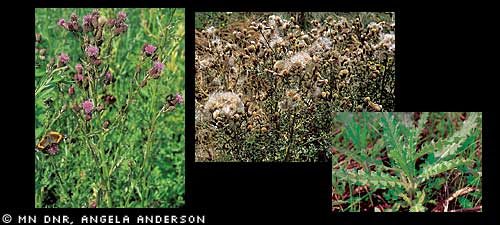
Identification:
Appearance: Perennial herbaceous plant, 2 – 5′ tall with slender grooved stems that branch only at the top. It has male and female plants.
Leaves: Alternate, smooth, oblong, tapering, and directly attached to the stem, deeply divided, with prickly margins.
Flowers: Numerous small purple flowers appear on top of the upper branched stems between June and September.
Seeds: Small light brown seeds are tufted for dispersal by the wind. Seeds remain viable in the soil for over 20 years.
Roots: Each plant has a fibrous taproot with wide spreading horizontal roots. Each small section of root can form a new plant enabling the plant to spread vegetatively.
Reasons Canada Thistle is a Problem:
- Canada thistle invades natural areas such as prairies, savannas, glades and dunes if some degree of disturbance already exists.
- Invades wet areas with fluctuating water levels such as stream banks, sedge meadows and wet prairies.
- Once established Canada thistle spreads quickly, replacing native plants
- Seeds are carried by wind and have high dispersal rates.
- Seeds remain viable in soil for up to 20 years.
- Also spreads vegetatively through horizontal roots, up to 10 -12′ in one season.
- Canada thistle occurs throughout the northern U.S. from northern California to Maine and southward to Virginia and in Canada.
Other Info:
Unlike its name suggests, Canada thistle is not native to Canada, but to Europe. It is well suited to growth in most of North American and as one of the most problematic agricultural plants has been declared a noxious weed in 43 states. Canada thistle is a rapid colonizer of disturbed areas, especially along roadsides. Plants growing on healthy prairies often produce little seed.
However, the seed of Canada thistle is its most problematic characteristic. The tufted, fluffy seeds are easily carried by the wind, I have watched one large conglomerate float from just north of Kettlehole Marsh to far over the western oak savanna, where it showed no signs of coming down. This is a convenient way to get rid of our unwanted seeds, but means dispersal and recruitment from the rest of the local region is difficult to control.
McKnight Prairie is an especially good place to view veritable thistle seed snow showers in the late summer. And then when it falls, Canada thistle seed remains viable in the soil for 20 years, meaning eradication efforts must be persistent and committed. The Arboretum experiences its most problems with Canada thistle in the newer prairie plantings, those that are in their first three growing seasons.
Other particularly bad patches include the southwest portion of the ’96 field, and the far southern end of the eastern Oak savanna. By the 2005 summer the latter patch had reached near species homogeneity in sections and was burned in the fall of ’05 so that seedlings could be sprayed early the next spring.
Cowling Arboretum Procedures for Removal:
Because of the dispersal abilities and long life of Canada thistle seed, eradication efforts are concentrated in the early summer during June and early July. Backpack sprayers are used to spray individual plants with herbicide, the process often requires large amounts of time walking back and forth across new prairies searching for small specimens. Occasionally, if herbicide is not used on some large patches before the creation of seed, the tactic switches to large scale collection of seed into plastic bags, to prevent its release into the environment.